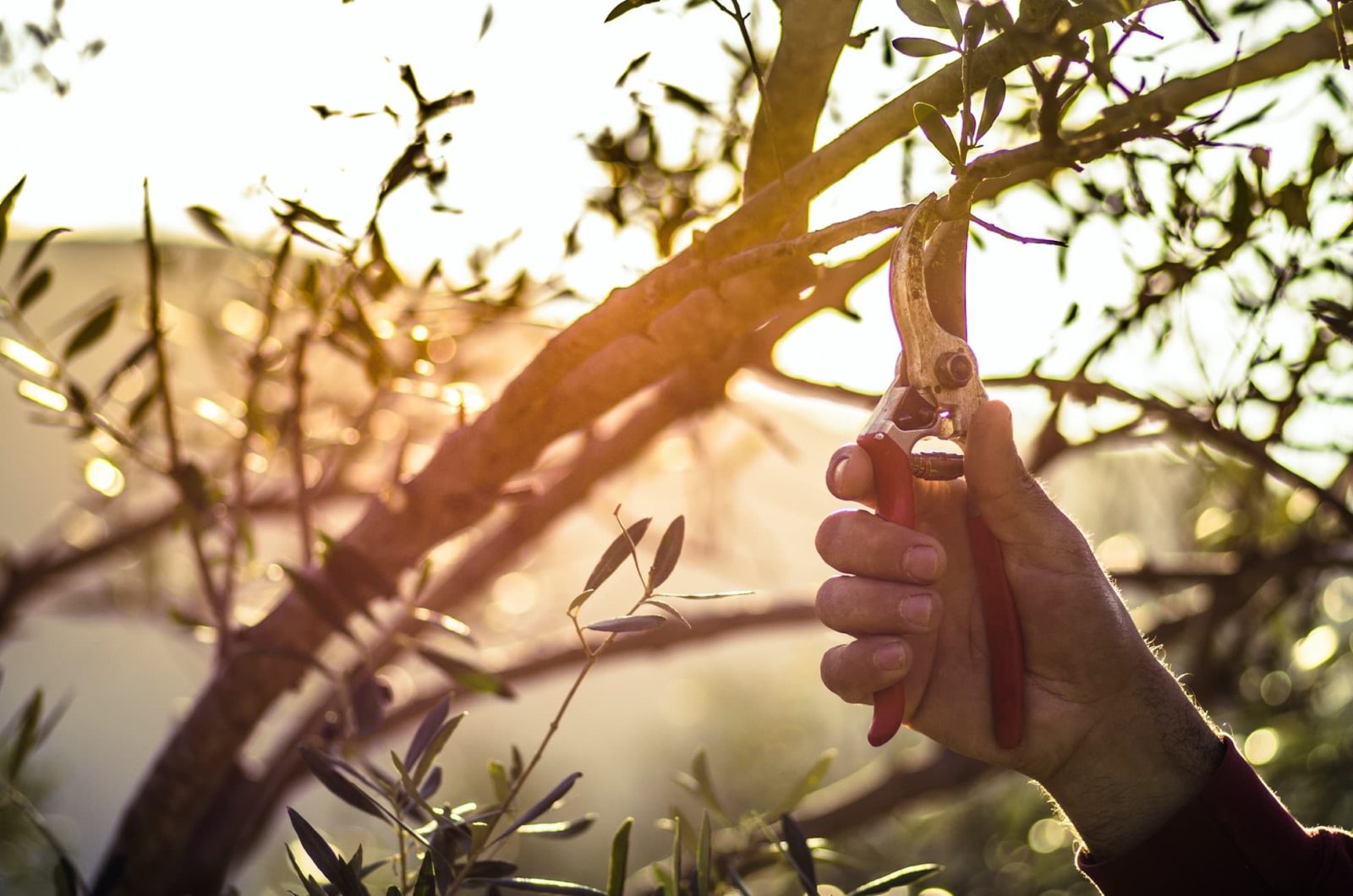Olives Respond Very Well To Pruning: Encourage Fruiting And Keep Your Plant In Check


Elizabeth is a Permaculture Garden Designer, Sustainability Consultant and Professional Writer, working as an advocate for positive change. She graduated from the University of St. Andrews with an MA in English and Philosophy and obtained a Diploma in Applied Permaculture Design from the Permaculture Association.
Reviewed By DAN ORI

Dan has over 27 years’ under his belt caring for plants and gardens. Working as a Horticultural Instructor and Consultant, he draws on a diverse range of experience that includes working as a Head Gardener, Tree Surgeon, Garden Centre Trouble Shooter, and writer of academic papers. Dan has a Level 3 Diploma in Horticulture and is currently a candidate for the RHS’s most prestigious award – The Master of Horticulture.
Contributions From PAUL & ANTONIA SMITH

With 30 years’ experience as an Arborist, Paul has a particular soft spot for olive trees, which he has been growing in the UK for over 10 years. The duo import their trees from licenced suppliers in Spain and select them by hand for their shape and form.
IN THIS GUIDE
OLIVE GUIDES
Container Growing
Pruning
Watering
Olive trees are beautiful Mediterranean trees that can look wonderful in a sheltered, warm spot here in the UK, but learning how to prune them correctly is important.
When and how to prune your olive tree and the reasons for doing so, will vary depending on why you are growing your olive tree, where you are growing it and what precisely you are aiming to achieve.
Olive trees can be beautiful trees to grow in a warm, Mediterranean-style garden.

Understanding how to care for your olive tree correctly is important and that includes understanding how and when to prune the tree.
When To Prune Olive Trees
First of all, whenever pruning an olive tree (for whatever purpose and with whatever goal) it is important to choose the right time for the job, as Paul Smith from The Norfolk Olive Tree Company explains:
“Like most evergreen trees, Olives respond very well to pruning. In fact, the more you prune, the happier they’ll grow”.
“However, is best to prune your Olive Tree after the last of the winter frost, from March onwards, and before the first autumn frosts, which is usually between late October and early November”.
Typically, you will prune an olive tree between late spring and the end of summer.

It is important not to prune your olive during the winter, as this can make the tree more vulnerable to infection with disease.
Always prune over the warmer part of the year to reduce the chances of disease taking hold.
Unfortunately, olive trees can be rather prone to a number of diseases, especially in a cooler climate.
Pruning incorrectly and at the wrong times can make it more likely that one will take hold.
Some only slightly impact the appearance of the tree, but some diseases could actually kill your olive tree outright.
Do They Need To Be Pruned?
Though pruning can often be a good idea, olive trees are relatively slow-growing and should not need a lot of pruning at all in most scenarios.
However, it is important to note that it is good practice (with an ornamental olive tree) to remove any dead, damaged or diseased materials as part of general care and maintenance.
If you are trying to grow an olive for its fruits, then the pruning considerations are somewhat different.

This is not always very easy in the UK, as the trees will typically only fruit in the mildest and warmest of UK gardens.
And even when the fruits do set successfully, you will still have to harvest the fruits before the first frosts and cure them before they are used.
Curing is essential if you want olives that taste like those you can buy in the shops.
Bear in mind that these trees thrive in the hot, long growing season of the Mediterranean and so work will be required to obtain an edible yield in our climate, with our much shorter growing season.
Another consideration is that here in the UK, olive trees are often grown in containers, and some pruning may be required for container-grown trees to keep their size in check and to stop them from outgrowing a container.
In short, therefore, you might wish to prune olive trees:
- For simple maintenance.
- To encourage fruiting and promote new fruit production.
- To keep the size and shape of the tree in check.
However, while olive trees can respond well to pruning, it is important not to go overboard.
Prune too excessively and the tree may put forth numerous water shoots (not fruiting growth).
This is not ideal if you are trying to produce fruit, of course.
It can also detrimentally affect the overall appearance of your olive tree.

Olives should usually be pruned quite lightly in order to preserve a more natural appearance, as Paul Smith advocates:
“Light and more light is the overwhelming principle of pruning. If you prune back your Olive Tree hard, this will result in a dense growth, whilst a light, formative prune will give your tree a natural shape.
“Also, letting the light into the tree improves fruit production and letting in the light also keeps the tree under control.
“If the tree is dark and dense, branches will race up and out to find more light, making the tree leggy”.
Maintenance Pruning
Usually, if an olive tree is growing in the ground, light, maintenance pruning is all that will be required.
Simply remove any branches which are causing damage by rubbing on one another, and any which have been damaged over the winter months in late spring or early summer.

At the same time, you may also prune some branches at the centre of the canopy to let more light in to new growth, and remove a side branch or two to maintain a pleasing shape.
But do not overdo it – less is usually more when it comes to maintenance pruning on an olive tree that is grown for ornamental reasons and not for its fruit.
Dan Ori recommends: “If you are not worried about impacting the fruiting, young olives can be trained and trimmed into attractive loose lollypop shapes; you will often see pairs of lollypop olives framing the doorways of opulent city homes.”
Pruning For Fruit
When pruning an olive tree for fruit, Paul Smith explains that one of the most important things to remember is that olives fruit only at the tips of the previous year’s growth.
“The olive tree produces fruit mainly at the periphery and top of the canopy. This is because these parts of the tree are fully exposed to sunlight and in turn improves fertility.
“When pruning for fruiting purposes, you should focus on the removal of any part that shades other younger parts of the tree”.
Pruning too zealously can prevent fruiting.
However, not pruning at all can lead, over time, to a tree with too much older wood, which may also restrict new growth and prevent light from reaching and ripening any fruits that do form on the last year’s branches.
It is a good idea, therefore, to prune out sections of old wood each year to allow some newer fruiting growth to form.
It is also recommended to thin fruits that form to no more than 3-4 for each 30cm of branch.
This should help ensure that the olives ripen successfully and will not drop off the tree prematurely before harvesting time.
“I recommend growing an olive in a pot against a sheltered sunny brick wall for the best chance of ripened olives,” says Dan Ori, a Member of the Arboricultural Association.
Pruning To Restrict Size & Preserve Form
Pruning to restrict size is not usually a concern when these slow-growing trees are grown in the ground.
But when they are grown in containers, you may need to do some additional pruning so they do not outgrow their pot.

In addition to the general maintenance pruning in the late spring or early summer, a container-grown olive may also require additional pruning in summer to restrict their size.
Paul Smith suggests that if your potted Olive Tree is not thriving in its pot, you can reduce the canopy size of your tree by up to one-third to keep its size in check and restore the plant’s health.
When olive trees in containers grown to around 1.5m tall, it is also often a good idea to prune to preserve or create a pleasing form.
Choose a few of the strongest and best-placed branches and keep these, but get rid of other shoots.
It should also be noted that you can take pruned branches in summer and use these as semi-ripe cuttings to propagate new olive trees from the parent plant.


You might also pinch out the growing tips to encourage branching and a bushier canopy.
Olive trees are not the easiest trees to care for and grow successfully in a UK garden, but pruning them is rarely a hugely complex business.
